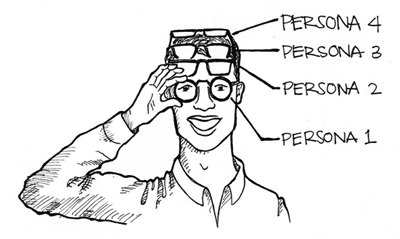Authors: Lauren Chapman Ruiz
Posted: Mon, August 11, 2014 - 12:43:17
It’s not uncommon to find yourself closely identifying with the users you are designing for, especially if you work in consumer products. You may even find yourself exposed to the exact experiences you’re tasked with designing, as I recently discovered when I went from researching hematologist-oncologists (HemOncs) and their clinics to receiving care from a HemOnc physician in his clinic. (Thankfully, all is now well with my health.)
This led to some revealing insights. Suddenly I was approaching my experience not just as a personal life event, but as both the designing observer, taking note of every detail, and the subject, or user, receiving the care. Instead of passively observing, I focused on engaging in a walk-a-mile exercise, literally walking in my own shoes, as my own user.
In the past, I’ve written about the importance of empathy in design, but this was an extreme. I was able to identify my personal persona, watch to confirm the validity of workflows, and direct multitudes of questions to the understanding staff members. This subsequent experience can be extremely positive, but reminded me of the dangers of biases and designing solely for one person.
For instance, most of my caregivers enjoyed chatting, and one even stated how fun it was to have a patient who inquired about everything. That was my reminder that most patients are not like me, not having studied this exact space, and therefore having less comfort in asking questions. I had to remember this was something unique.
When we find ourselves in these situations, we need to remember that what happens to us may enhance our knowledge, but it cannot become the only conceivable experience in our minds. Too often we can walk dangerously close to designing for ourselves or for “the identifiable victim.” However, this can cause us to lose focus on improving outcomes for “the many” by single-mindedly pursuing an individual solution to a particularly negative outcome.
A New Yorker article called “Baby in the Well” builds a case against empathy, pointing out that this can cause us to misplace our efforts, missing the needs of “the many.” It is shown that the key to engaging empathy is the “identifiable victim effect,” which is the tendency for people to offer greater aid when a specific, identifiable person, or “victim” is observed under hardship, as compared to a large and vaguely defined group with the same need. The article states:
As the economist Thomas Schelling, writing forty-five years ago, mordantly observed, “Let a six-year-old girl with brown hair need thousands of dollars for an operation that will prolong her life until Christmas, and the post office will be swamped with nickels and dimes to save her. But let it be reported that without a sales tax the hospital facilities of Massachusetts will deteriorate and cause a barely perceptible increase in preventable deaths—not many will drop a tear or reach for their checkbooks.
When we design, we pursue a broader type of empathy. As a colleague once said to me, designers need to identify with the whole user base. User-centricity is about the ability to recognize that there are a number of personas, each with different goals, desires, challenges, behaviors, and needs. We design for these personas, recognizing that each has different goals they’re trying to accomplish and with different behaviors in how they go about achieving them.

So what are the key takeaways from my experience?
- Situations that help us build empathy for our users are invaluable as it gives us deep knowledge, but we should recognize and feel empathy for many. Looking at our situations through the lenses of your multiple personas can help you avoid this trap.
- Remember that the empathy we look to build in design is not just about feelings, but rather about understanding goals, the reasons for these goals, and how they are or aren’t currently accomplished.
- Have some empathy for yourself—it’s hard to untangle our personal feelings from the work we do on a day-to-day basis. Remember, we’re all human, and we will fall into the trap of focusing on ourselves from time to time. Recognizing this and looking out for the places where it affects our work is the best we can do.
What about you—have you found yourself in similar situations? How have you approached it? Are there tricks you use or pitfalls you work to avoid? Please use the twitter hashtag #designresearch to share in the conversation.
Illustration by Cale LeRoy
Posted in: on Mon, August 11, 2014 - 12:43:17
Lauren Chapman Ruiz
View All Lauren Chapman Ruiz's Posts







Post Comment
@Jake (2024 07 09)
When we find ourselves in these circumstances, we must keep in mind that while what happens to us may broaden our understanding, it cannot replace all other experiences as plausible in our imaginations. See: turf pros el paso
@Damian (2024 10 25)
I wish I were more empathetic! But it is a skill, not something we are born with.
@MosheTreutel (2025 07 29)
Every jump, every glide is perfectly synchronized with the vibrant background music, giving the feeling of playing music by hand extremely attractive. Geometry Vibes is not just a game, but an emotional journey, where players are drawn into the non-stop flow of sound and light.